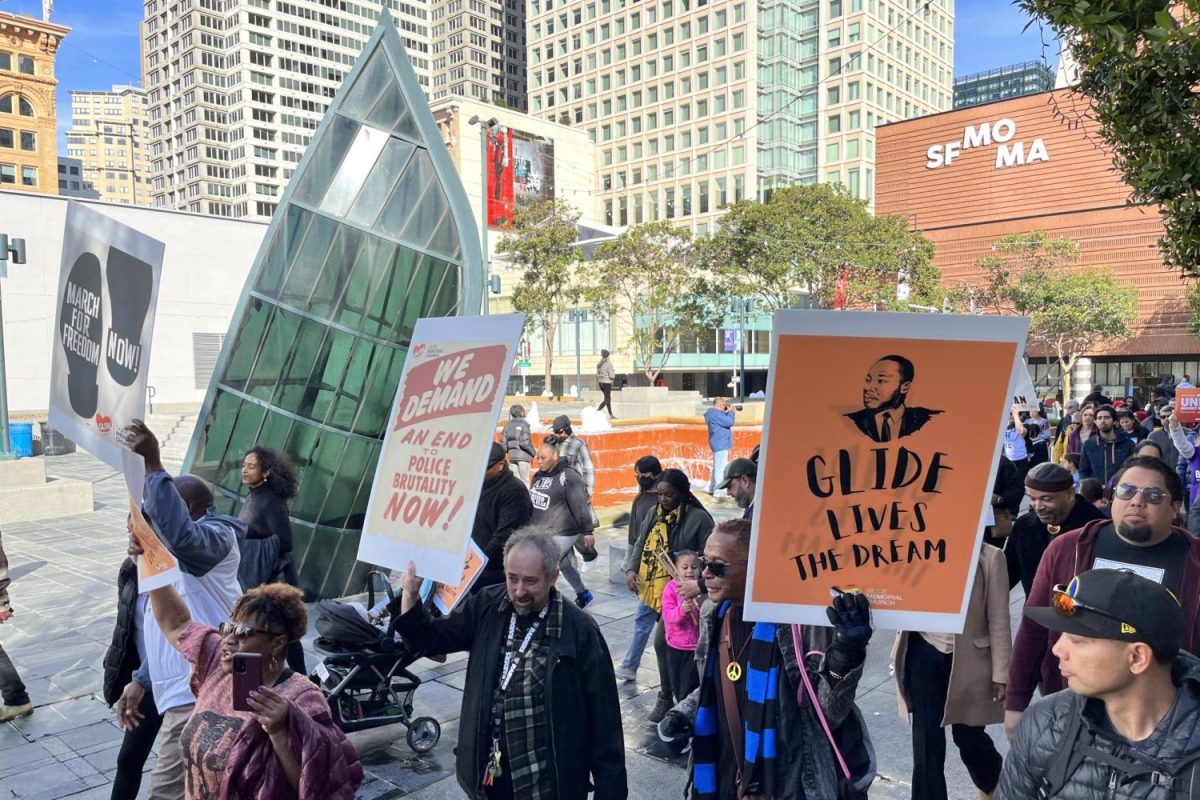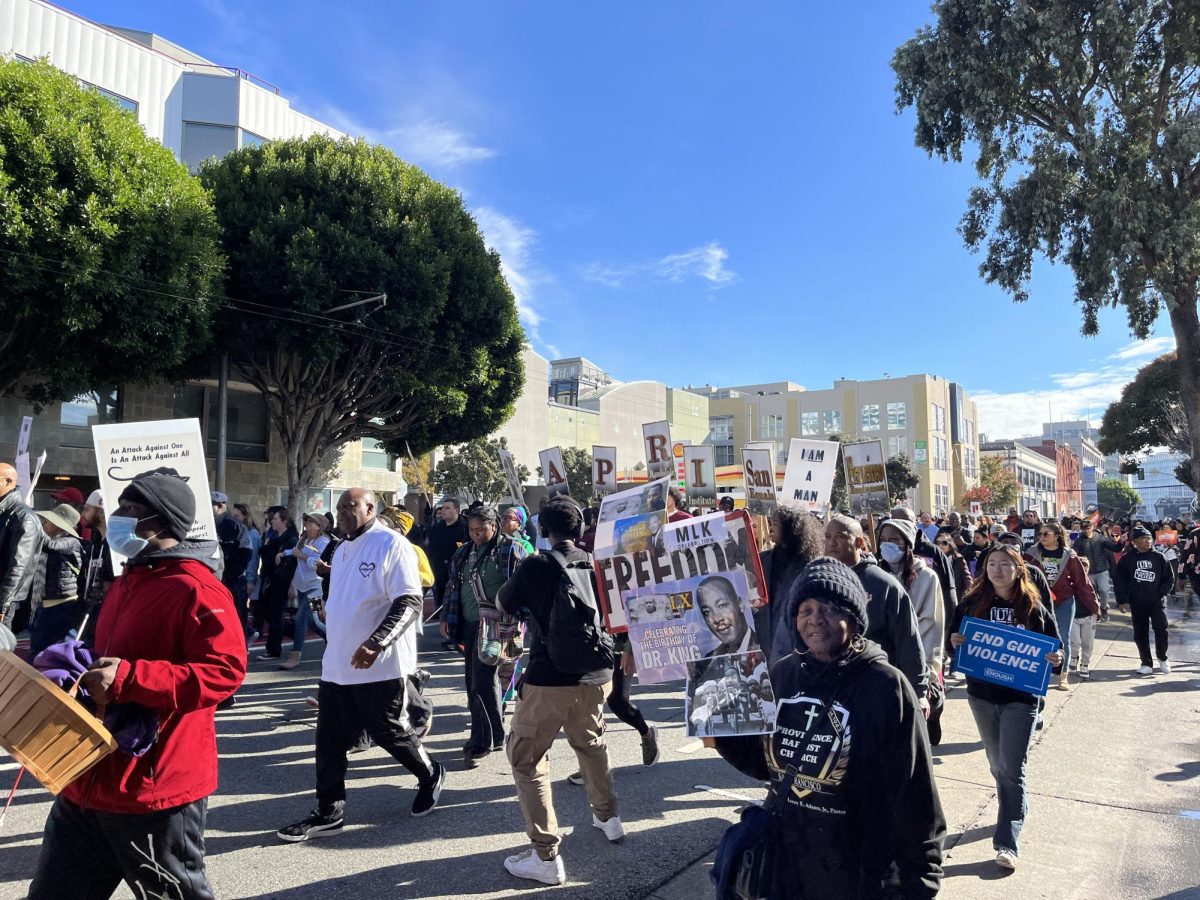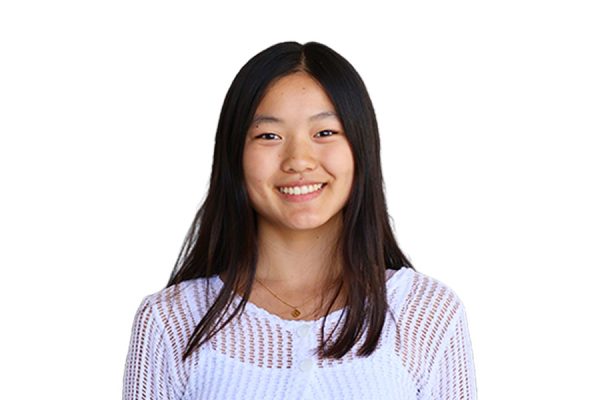Beginning at Caltrain’s 4th and King Station, attendees of the annual San Francisco Martin Luther King Jr. Day march wave signs, play music, and sing as they make their way through closed-off streets to Yerba Buena Gardens.
Thousands of participants marched from 11:00 a.m. to 12:00 p.m. before congregating at Yerba Buena for speeches by Mayor London Breed and leaders of United Playaz, a violence-prevention organization, as well as musical performances.
The park features a Martin Luther King Jr. memorial, allowing attendees to stroll beneath its waterfalls and read the carvings of King’s words. Alongside the memorial and performances, the Yerba Buena Center for the Arts also presented the Black & Brown Comix Arts Festival (BCAF) and multicultural literature.
Events like these are common on the third Monday of every January, a day that is reserved to honor the civil rights activist and minister, Martin Luther King Jr., for his efforts during the civil rights movement of the mid-20th century.
Born on Jan. 15, 1929, in Atlanta, Georgia, King became aware of racial segregation from a young age. In 1955, inspired by Rosa Parks’ refusal to give up her seat on a bus to a white passenger and her arrest as a result of Montgomery’s segregation laws, King was chosen to lead the Montgomery bus boycott, beginning his work as a civil rights activist.
From there, King helped found the Southern Christian Leadership Conference (SCLC) in 1957 to support his and other local efforts for equal rights for African Americans. A few years later, in Birmingham, Alabama, King was jailed for campaigning against segregation at lunch counters. His influential 1963 letter from the Birmingham jail showed his ability to write and his philosophy of nonviolence, which was inspired by Mohandas Gandhi.
The same year, King joined with other civil rights activists to organize the March on Washington, where more than 200,000 people gathered at the Lincoln Memorial for equal treatment of all citizens.
The success of the movement led to the passage of the Civil Rights Act of 1964, desegregating public accommodations and banning discrimination in both public spaces and employment. King was awarded the Nobel Peace Prize that December.
According to Aaron Grizzell, executive director of the Northern California Dr. Martin Luther King Jr. Community Foundation (NorcalMLK), the organization was started in 1985 by King’s wife, Coretta Scott King, and Rev. Cecil Williams from Glide Church to host the Martin Luther King Jr. holiday events in the area, such as the 2024 march and celebrations.
“Dr. King saw the San Francisco community as very important to his work. He first came to the city following the Montgomery bus boycott to speak to the gathering of the National Association for the Advancement of Colored People (NAACP),” Grizzell said.
According to Grizzell, King, a Christian minister, regularly spoke at churches in the area. After completing a five-day march from Selma, Alabama, to Montgomery, Alabama in 1965 to emphasize the importance of passing the Voting Rights Act, King spoke to a crowd of more than 5000 at San Francisco’s Grace Cathedral.
“The importance of his impact on the community can be seen and felt at the Martin Luther King, Jr. Memorial and Waterfall at Yerba Buena Gardens. Today, it is the third-largest monument built in honor of Dr. King in the United States,” Grizzell said.
NorcalMLK partnered with Yerba Buena Gardens in providing both Grammy-winning and local artists, as well as comic book creators of color.
“Over the last ten years, NorcalMLK has been a place for creators to come and show their work to the world,” Grizzell said.
For Breed, who has been mayor of San Francisco since 2018, the event is special because she can trace it back to her childhood.
“What I noticed about this event more than most events is that it not only celebrates Dr. King’s legacy, but also brings a lot of joy, love, and desire to have unity,” Breed said.
Ana Maria Johnson is a member of the African American and Latino Parent Association (AALPA) of St. Ignatius High School, a group that works for inclusivity at both the school and the community.
“Being here at the march is a celebration of all the values Dr. King has brought forth on social justice, inclusivity, diversity, and love. It’s representative of what we try to do day in and day out to support our community,” Johnson said.
For Johnson, the significance of the celebration is the continuation of King’s impact and the remembrance of the history and struggle it took for generations to come.
“My favorite part is seeing the diversity of everyone coming out in support with the same voice and recognizing the ongoing social justice issues that we face. But today’s event also shows how much unity there is, so it’s very rewarding to see everyone on the same page,” Johnson said.
Other groups, such as firefighters from the San Francisco Fire Department (SFFD), the NAACP, and members of the A. Philip Randolph Institute San Francisco (APRISF), a non-profit organization that supports racial equality and disadvantaged communities, also took part in the march and festivities.
Sammy Halimi is a member of the Party for Socialism and Liberation, another organization that attended the march and the following event at Yerba Buena Gardens.
“Martin Luther King Jr. stands out as an inspirational figure for people across the aisle. When he said that he had a dream on the steps of the Lincoln Memorial he wasn’t saying that because it was easy or that there was already popular support for it. Everyone was critical of it at the time, so one of the things we think is important is his radical legacy,” Halimi said.
Just outside of the Yerba Buena Center for the Arts, Grady Turner plays the drums at a stall. Turner has been playing the drums for 15 years and coming to the event for the past five to 10 years — returning after a pause due to quarantine.
“We’re here for community and freedom. We’ve got to fight against racism. You’ve got to stand up. If you don’t stand for something you’ll fall for anything. My goal is to try to meet as many people as I can because this event brings people together,” Turner said.
Each year, Turner rides Caltrain’s Celebration Train, also known as the Freedom Train, which runs for free from San Jose to San Francisco on the holiday. During the ride, many musicians, including Turner, play music and sing for passengers. Performances continue into the event.
“Music alone is universal. It’s what brings the world together. We always get together here to talk about it and everybody’s having fun. We come and create a fellowship out here,” Turner said.
Inside the Yerba Buena Center for the Arts, Murphy Milburn displays his miniature comic books inspired by retro art styles at the Black & Brown Comix Arts Festival. Milburn is among the many unique artists featured at the event who came to exhibit their work and be around other artists of color.
“Dr. King’s significance was his radicalism. We’ve made progress, but we’ve still got a lot of work to do,” Milburn said.
Further into the building, Deborah Day, founder and CEO of Ashay By The Bay, a Black children’s bookstore specializing in African American and multi-cultural books, runs a stand presenting the variety of literature the store provides.
“When I started this store 23 years ago, we didn’t have the depth and breadth of the books we have now. We wanted to have a destination where people could find books for our kids because we haven’t had access to the right books for so long. Now, we have Spanish bilingual books and Asian American, Native American, and Middle Eastern stores,” Day said.
Day encourages adults and children alike to read more, as children often follow their parents’ examples. In order to provide the community with the opportunity to do so, she has been coming to Martin Luther King Jr. Day celebrations around California for almost 20 years.
“San Francisco has a lot of events attached — they have a parade, breakfast, and speeches. It’s a great event but we’ve also got to be mindful of how important Dr. King was. He and other great leaders started revolutions and led movements. We know as black people that many other groups have benefited from his work, so it’s always good to recognize him and everything he did,” Day said.
For San Francisco residents, the event served as a way to be a part of the community and share the celebrations.
While King’s life was unexpectedly cut short many years ago, such events that reunite communities annually continue to bring attention to his life’s mission for social justice and equality.
“Oftentimes people will carry Dr. King’s legacy with them. They’re reminded in events like this every year of how much more we are alike and how much more we need one another in order to push for transformative change that impacts all of us. It’s wonderful to be here to celebrate and to come together. It just feels amazing,” Breed said.













